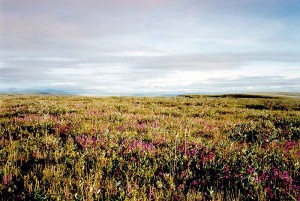16 December 2013
As the Earth warms, Arctic tundra rots
Melting ice caps may not be the only problem the Arctic has to worry about as the climate changes. As temperatures rise, permafrost melts earlier and stays wet longer. When plants and other organic material in the soil thaw, they decompose, releasing huge quantities of methane and carbon dioxide.
By some estimates, 190 billion tons of carbon could be released into the atmosphere by 2020 as permafrost disappears. That’s half as much carbon as humans have released into the atmosphere since the Industrial Revolution. The melting of permafrost is a vicious cycle. More carbon in the atmosphere translates into faster warming of the planet, which releases more carbon.
Scientists at Oak Ridge National Laboratory are trying to model this changing system in a project spanning a wide range of disciplines, including mathematics, geophysics, hydrology, and geochemistry.
“As the temperature goes up, the ground doesn’t freeze,” said Nathan Collier, a co-author on a poster presented Thursday during the American Geophysical Union’s Fall Meeting in San Francisco. He and his colleagues are studying how water moves through the permafrost using equations that model changes through space and time.
The spread of water through the soil, fed by thawing ground and precipitation, affects the decomposition of previously frozen ground. But the models are incredibly complex: not all rainfall makes it far into the earth, as plants gobble it up. Mapping different layers of soil and rock throws additional wrenches in the system
“The challenge is, in reality, the material properties change rapidly,” Collier said. “We have to look at how porous the soil is, but the earth is really heterogeneous. It’s incredibly hard to capture.”
To build the model, researchers split a few hundred meters in Barrow, Alaska, into 13.5 million cells, which function similarly to pixels. To each cell, they applied previously existing differential equations to data gathered by experimental researchers. This helped them model how water flows through the ground and, ultimately, how it affects the carbon cycle.
Oak Ridge scientists hope to add their data to global climate change models, giving researchers and policymakers a more complete picture of how the Earth is affected by the release of greenhouse gases.
Collier hasn’t made it up to the Arctic yet, but he hopes to soon. “They want to send all of us up there, to help us get a better picture of what we’re modeling,” he said.
– Cat Ferguson is a science communication graduate student at UC Santa Cruz




 GeoSpace is a blog on Earth and space science, managed by AGU’s Public Information staff. The blog features posts by AGU writers and guest contributors on all sorts of relevant science topics, but with a focus on new research and geo and space sciences-related stories that are currently in the news.
GeoSpace is a blog on Earth and space science, managed by AGU’s Public Information staff. The blog features posts by AGU writers and guest contributors on all sorts of relevant science topics, but with a focus on new research and geo and space sciences-related stories that are currently in the news.